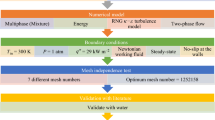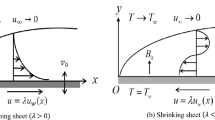Abstract
This article explores the role of hybrid nano-particles in enhancing the thermal performance of Sutterby fluid over a two-dimensional body of variable thickness. Copper and aluminum oxides are dispersed in the Sutterby liquid simultaneously. The models for effective thermal properties of hybrid nano-fluids (a mixture of copper oxide, aluminum oxide, and Sutterby fluid) are used to model the transport of heat which results in a set of complex mathematical equations for momentum and energy conservation. These equations are solved numerically by finite element method (FEM). FEM methodology is tested and validated. An excellent agreement between the present and the published benchmarks is found. The parametric investigation is carried out, and a significant improvement in the thermal performance of Sutterby fluid due to hybrid nano-particles (copper oxide and aluminum trioxide) is observed. The wall heat flux for hybrid nano-Sutterby fluid (a mixture of cupper oxide, aluminum trioxide and Sutterby fluid) is significantly found to be greater than the thermal performance of a mixture of aluminum trioxide and the Sutterby fluid. The present work is a generalization of already published works. Therefore, the present work is retrieved into the previous special cases and the results are validated by comparing it with already published works. A good agreement between the present and the already published work is found. The wall shear stress and rate of heat transport increase when the Reynolds and the Deborah numbers are increased.









Similar content being viewed by others
Change history
07 July 2020
A Correction to this paper has been published: https://doi.org/10.1007/s10973-020-10009-1
References
Sheikholeslami M, Saleem S, Shafee A, Li Z, Hayat T, Alsaedi A, Ijaz Khan M. Mesoscopic investigation for alumina nanofluid heat transfer in permeable medium influenced by Lorentz forces. Comput Methods Appl Mech Eng. 2019;349:839–58.
Hayat T, Aziz A, Muhammad T, Alsaedi A. Numerical simulation for three-dimensional flow of Carreau nanofluid over a nonlinear stretching surface with convective heat and mass conditions. J Braz Soc Mech Sci Eng. 2019. https://doi.org/10.1007/s40430-018-1540-7.
Li Z, Sheikholeslami M, Mittal AS, Shafee A, Haq RU. Nanofluid heat transfer in a porous duct in the presence of Lorentz forces using the lattice Boltzmann method. Eur Phys J Plus. 2019;134(1):12406–8.
Sadiq MA, Khan AU, Saleem S, Nadeem S. Numerical simulation of oscillatory oblique stagnation point flow of a magneto micropolar nanofluid. RSC Adv. 2019;9:4751–64.
Saleem S, Firdous H, Nadeem S, Khan AU. Convective heat and mass transfer in Magneto Walter’s B nanofluid flow induced by a rotating cone. Arab J Sci Eng. 2019;44(2):1515–23.
Sheikholeslami M. Finite element method for PCM solidification in existence of CuO nanoparticles. J Mol Liquids. 2019;265(1):347–55.
Dogonchi AS, Tayebi T, Chamkha AJ, Ganji D. Natural convection analysis in a square enclosure with a wavy circular heater under magnetic field and nanoparticles. J Therm Anal Calorim. 2019. https://doi.org/10.1007/s10973-019-08408-0.
Sheikholeslami M. New computational approach for energy and entropy analysis of nanofluid under the impact of Lorentz force through a porous media. Comput Methods Appl Mech Eng. 2019;344(1):319–33.
Sattar Dogonchi A, Tayebi T, Chamkha JA, Ganji D. Natural convection analysis in a cavity with an inclined elliptical heater subject to shape factor of nanoparticles and magnetic field. Arab J Sci Eng. 2019;44:7919–31.
Sheikholeslami M, Rezaeianjouybari B, Darzi Ahmad Shafee M, Lie Z, Nguyen TK. Application of nano-refrigerant for boiling heat transfer enhancement employing an experimental study. Int J Heat Mass Transf. 2019;141:974–80.
Rehman UK, Awais M, Hussain A, Kousar N, Yousaf Malik M. Mathematical analysis on MHD Prandtl–Eyring nanofluid new mass flux conditions. Math Meth Appl Sci. 2018;42(1):1–15.
Ramzan M, Sheikholeslami M, Saeed M, Dong Chung J. On the convective heat and zero nanoparticle mass flux conditions in the flow of 3D MHD Couple Stress nanofluid over an exponentially stretched surface. Sci Rep. 2019;9:562.
Majeed A, Zeeshan A, Hayat T. Analysis of magnetic properties of nano-particles due to applied magnetic dipole in aqueous medium with momentum slip condition. Neural Comput Appl. 2019;31(1):189–97.
Saleem S, Nadeem S, Rashidi MM, Raju CSK. An optimal analysis of radiated nanomaterial f low with viscous dissipation and heat source flow with viscous dissipation and heat source. Microsyst Technol. 2019;25(2):683–9.
Nadeem S, Abbas N, Khan AU. Characteristics of three dimensional stagnation point flow of Hybrid nanofluid past a circular cylinder. Results Phys. 2018;8:829–35.
Nadeem S, Hayat T, Khan AU. Numerical study on 3D rotating hybrid SWCNT–MWCNT flow over a convectively heated stretching surface with heat generation/absorption. Phys Scr. 2018;94(7):075202.
Iqbal Z, Akbar NS, Azhar E, Maraj EN. Performance of hybrid nanofluid (Cu–CuO/water) on MHD rotating transport in oscillating vertical channel inspired by Hall current and thermal radiation. Alexand Eng J. 2018;57(3):1943–54.
Nadeem S, Abbas N. On both MHD and slip effect in micro-polar hybrid nano-fluid past a circular cylinder under stagnation point region. Can J Phys. 2019;97(4):392–9.
Sheikholeslami M, Mehryan SAM, Shafee A, Sheremet MA. Variable magnetic forces impact on magnetizable hybrid nanofluid heat transfer through a circular cavity. J Mol Liquids. 2019;277:388–96.
Imtiaz M, Kiran A, Hayat T, Alsaedi A 2019 Joule heating and MHD effects in flow of second grade fluid due to a rotating disk with variable thickness. Phys Scr. 2019;94:085203.
Hayat T, Ullah I, Alsaedi A, Ahmad B. Variable aspects of double stratified MHD flow of second grade nanoliquid with heat generation/absorption: a revised model. Radiat Phys Chem. 2019;157:109–15.
Nawaz M, Rana S, Haider Qureshi I, Hayat T. Three-dimensional heat transfer in the mixture of nano-particles and micropolar MHD plasma with hall and ion slip effects. AIP Adv. 2018;8:105109–17.
Nawaz M, Rana S, Haider Qureshi I. Computational fluid dynamic simulations for dispersion of nano-particles in a magnetohydrodynamic liquid: a Galerkin finite element method. RSC Adv. 2018;8:38324–35.
Nawaz M, Zubair T. Finite element study of three dimensional radiative nano-plasma flow subject to Hall and ion slip currents. Results Phys. 2017;7:4111–22.
Haider Qureshi I, Nawaz M, Shahzad A. Numerical study of dispersion of nano-particles in magnetohydrodynamic liquid with Hall and ion slip currents. AIP Adv. 2019;9(2):025219. https://doi.org/10.1063/1.5084311.
Qureshi IH, Nawaz M, Rana S, Zubair T. Galerkin finite element study on the effects of variable thermal conductivity and variable mass diffusion conductance on heat and mass transfer. Commun Theor Phys. 2018;70(1):049.
Nawaz M, Arif U, Haider IQ. Impact of temperature dependent diffusion coefficients on heat and mass transport in viscoelastic liquid using generalized Fourier theory. Phys Scr. 2019. https://doi.org/10.1088/1402-4896/ab1cec.
Fang T, Zhang J, Zhong Y. Boundary layer flow over a stretching sheet with variable thickness. J App Math Comput. 2012;218:7241–52.
Khader MM, Megahed AM. Numerical solution for boundary layer flow due to a nonlinearly stretching sheet with variable thickness and slip velocity. Eur Phys J Plus. 2013;128(9):100. https://doi.org/10.1140/epjp/i2013-13100-7.
Acknowledgements
Authors would like to express their gratitude to King Khalid University, Abha 61413, Saudia Arabia for providing administrative and technical support.
Author information
Authors and Affiliations
Corresponding author
Additional information
Publisher's Note
Springer Nature remains neutral with regard to jurisdictional claims in published maps and institutional affiliations.
Rights and permissions
About this article
Cite this article
Arif, U., Nawaz, M., Alharbi, S.O. et al. Investigation on the impact of thermal performance of fluid due to hybrid nano-structures. J Therm Anal Calorim 144, 729–737 (2021). https://doi.org/10.1007/s10973-020-09493-2
Received:
Accepted:
Published:
Issue Date:
DOI: https://doi.org/10.1007/s10973-020-09493-2




